“How to Fish for Trout in a River” is commonly asked by many anglers, as depending on where you live, it can be hard to imagine how many trout are in local rivers and where they are.
Fishing for trout in rivers requires some critical knowledge and equipment. Whether you are fishing with a standard rod and reel or fly fishing, understanding the behavior of trout will give you insight into what they are eating, what parts of the river the trout are in, and why.
Continue reading for all the details you need to know to fish for trout in rivers, including where and how to cast.
Trout Behavior in a River
One of the essential parts of understanding how to fish for trout in a river is their behavior—knowing where trout like to be and how they will give you an idea of what you want to cast toward and what bait to use.
1. Trout Prefer Cold, Flowing Water
Trout are cold-water fish that prefer to live in streams, rivers, and lakes with cool, flowing water. They have adapted to living environments with high oxygen levels, typically in cold, well-oxygenated water.
Additionally, trout need a steady supply of food and prefer areas where food is concentrated and easily accessible.
In flowing water, trout can position themselves in areas where food is carried to them by the current.
Cold water also helps to regulate the trout’s body temperature, which can be essential for their metabolism and overall health.
For these reasons, trout tend to be found in areas with good water quality and a steady supply of cool, flowing water.
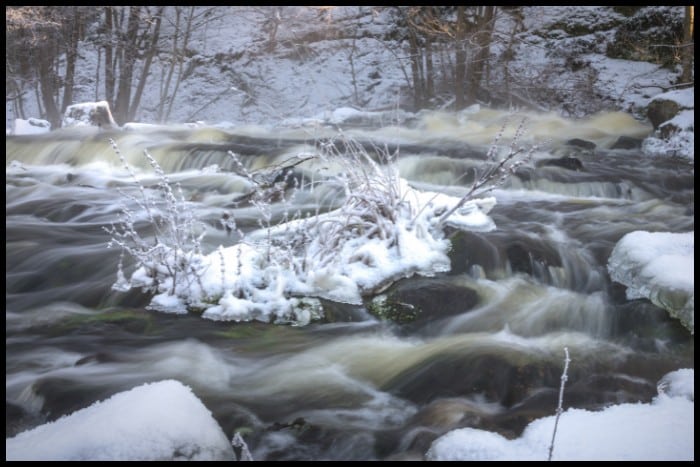
2. Trout are Ambush Predators
Trout are known as ambush predators, meaning that they hide from their prey or use camouflage rather than actively trying to pursue it and then strike when an unwary bait fish or insect gets too close.
They typically position themselves in areas where food is concentrated, such as behind rocks, in eddies, or at the tail end of pools.
When prey comes within striking distance, the trout will quickly dart forward and grab it with their sharp teeth.
Successful trout anglers often use lures and baits that mimic the natural movements of prey and are presented in a way that makes them look like an easy meal for an unsuspecting trout.
My guide on the best trout fishing baits will help you learn more about this topic.
3. Light Levels Affect Trout Behavior
Light levels can have a significant impact on trout behavior. Trout are generally more active during low-light periods, such as the early morning or late evening when the sun is low on the horizon.
During these times, trout may move into shallower water to feed and may be more susceptible to angling.
Conversely, during periods of bright sunlight, trout may become more skittish and move to deeper, more shaded areas of the river.
Bright light can also make it easier for trout to spot potential predators, so they may be more cautious and less likely to feed.
Understanding how light levels affect trout behavior can help anglers choose the right time and place to fish for these elusive fish.
4. Structure is Important for Trout
The structure is essential for trout because it provides shelter and a place to hold in the river. Trout are ambush predators that rely on structure to hide from prey and to conserve energy in the river’s current.
Structures like boulders, logs, and undercut banks can be natural or artificial, like bridge pilings, culverts, and man-made structures.
Trout will position themselves in the eddies and seams behind structures where the water is slower and food is more easily accessible.
Understanding the importance of structure can help anglers identify where trout are likely to hold and increase their chances of catching these elusive fish.
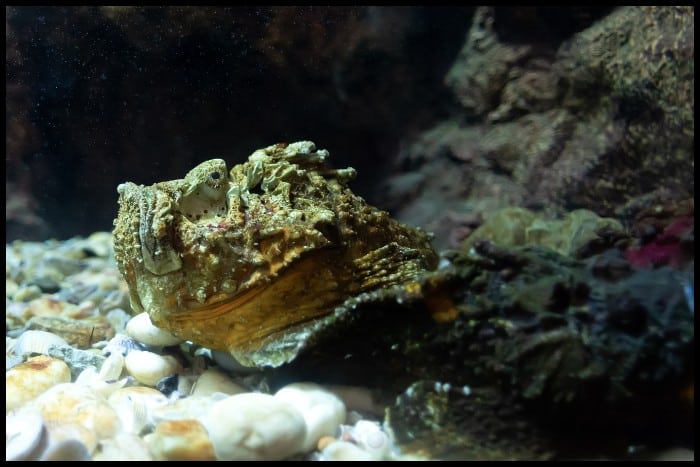
5. Trout Stay Near Food Sources
Trout are opportunistic feeders that will stay close to food sources in the river. Their diet includes insects, baitfish, crustaceans, and other aquatic organisms.
Understanding the types of food available in the river and where they are likely to be found can help anglers identify where trout are holding and increase their chances of catching them.
For example, trout often position themselves near riffles and seams where insects and baitfish are likely to be concentrated.
They may also hold behind structures or near the bottom of the river where they can find food and avoid the current.
Staying close to food sources is essential for trout survival and an important consideration for successful trout fishing.
6. Trout are Sensitive and Skittish
Trout are known to be sensitive and skittish fish, which can make them a challenging target for anglers.
They have a well-developed sense of vision, smell, and hearing, which they use to detect predators and avoid danger.
Trout can easily be spooked by the presence of humans, loud noises, and sudden movements, causing them to become less active and more difficult to catch.
To successfully target trout, anglers must be stealthy and use tactics like sight-fishing or naturally presenting their bait or lure.
What Lures to Use for Trout and How to Use Them?
Choosing the correct lures or baits is as vital as casting in the right area; presentation can make or break the lure. Below are some popular lures for trout fishing and how to use them.
Also, do check out my article on trout fishing setup for beginners if you need a good starting point!
1. Popular Trout Lures
Many popular lures are used for trout fishing, and the best choice will depend on the conditions, water type, and species of trout being targeted.
Some popular lures include spinners, spoons, crankbaits, jigs, and soft plastics.
Spinners and spoons imitate the natural movements of small bait fish or insects, while crankbaits create a more erratic action that can trigger a predatory response.
Jigs and soft plastics are often used in deeper water or when targeting larger trout. Experimenting with different lures and techniques can help you find what works best for your fishing situation.
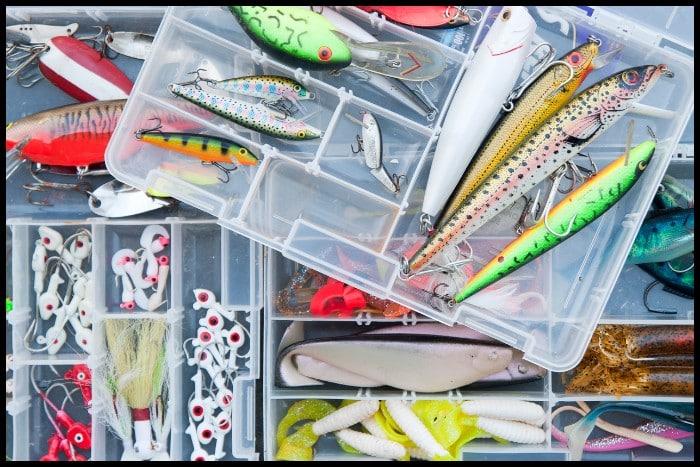
2. Popular Trout Baits
Trout are also commonly caught using natural baits such as worms, insects, eggs, and other tiny organisms found in the river.
Worms and insects are popular choices, with anglers often using live bait or artificial imitations such as fly patterns.
Powerbait and other dough baits are also widely used by trout anglers, especially in stocked ponds or lakes. Salmon eggs, cheese, and corn are other popular bait options.
The key to successfully using bait is to match the bait to the natural food sources found in the river and present it in a natural way.
A small hook and light line will also increase your chances of hooking into a trout.
3. Casting Up or Downstream?
When casting in a river for trout, it’s essential to understand the water flow and the fish’s position.
One effective technique is to cast upstream and allow your bait or lure to drift naturally with the current while keeping your line taut and ready to set the hook.
Another technique is to cast across the river and retrieve your bait or lure in a slow, natural manner, mimicking the movement of prey in the water.
Accuracy and stealth are also important, as trout are sensitive to movement and vibrations in the water.
Practice your casting skills and adjust your technique to suit the conditions to increase your chances of success when targeting trout.
4. Retrieving the Lure
Retrieving the lure to mimic the movement of natural prey is essential when targeting trout.
One effective technique is the “slow and steady” retrieve, where the angler reels in the lure at a steady pace with small pauses to give the lure a more natural, erratic movement.
Another technique is the “jerk and pause,” where the angler quickly jerks the rod tip to create a sudden movement in the lure, then allows it to pause and drift with the current.
Varying the retrieve speed, depth, and direction can help to trigger a predatory response from the trout and increase your chances of success.
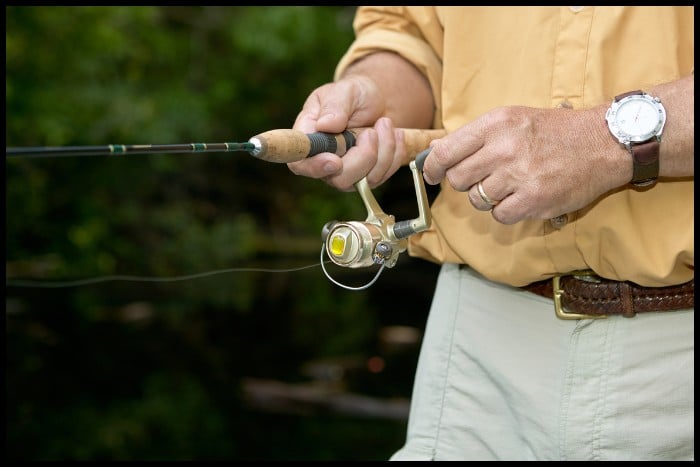
5. How to Set the Hook on Trout
Setting the hook on a trout can be tricky because they have a relatively soft mouth and can spit the hook quickly.
In order to set the hook, anglers should keep the line tight and use a quick upward motion of the rod tip to pull the hook into the fish’s mouth.
Once the hook is set, anglers should reel in the line steadily, keeping it taut and avoiding slack that can allow the fish to escape.
Gradually tiring the fish is crucial, using the drag system on the reel to apply steady pressure and prevent the line from breaking.
When the fish is close enough, use a net or carefully lift it out of the water, remove the hook quickly and gently, and then release the fish back into the water.
6. How to Safely Handle Trout
When handling trout, it’s essential to do so gently and carefully to avoid harming the fish.
Wetting your hands before handling can help to protect the trout’s sensitive skin and slime coating, which dry hands can easily damage.
Support the fish from underneath, and avoid squeezing or pressing on its body or gills, which can cause injury or stress.
If using a net, make sure it is made of soft material and is large enough to accommodate the fish without overcrowding.
If taking photos, handle the fish quickly and avoid keeping it out of the water for too long. When releasing the fish, hold it gently in the water and allow it to swim away.
Where to Cast to Catch River Trout?
A good cast needs a good rod and a reel to begin with. I have some awesome recommendations for you:
Finally, with the right lure selected for your river, you can choose the right areas to cast in where the trout are hiding.
Stealth is critical, as you don’t want to spook the fish as you approach the river, and cast the lure gently to not spook the fish either.
1. Pools are Common Places For Trout
Trout often seek out pools in rivers because they offer a variety of favorable conditions for the fish.
Pools typically have slower water flow than riffles or runs, providing a place for trout to conserve energy and avoid being swept downstream.
Pools also provide deeper water for the fish to retreat to during periods of high heat or low water levels.
Additionally, pools can be a refuge for trout from predators or fast-moving currents and may offer rich food sources such as insects, small fish, and other aquatic organisms.
For these reasons, pools are often productive areas for trout anglers to target when fishing in rivers.
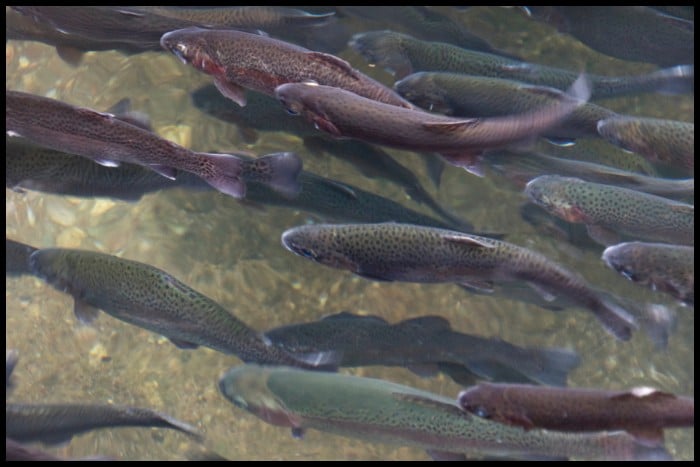
2. Trout Stay Near Runs in the River
Trout are also commonly found in runs in rivers, which are areas of faster water flow than pools.
Runs are often formed by water flowing over shallower, rocky riverbed areas and can provide various benefits for trout.
The quicker water flow in runs can help to oxygenate the water, making it more suitable for trout to breathe.
Water movement can also dislodge insects and other prey items, providing food for the fish.
Additionally, runs can serve as travel corridors for trout moving upstream or downstream, making them a prime area for anglers to target when looking for actively feeding fish.
3. Undercut Banks Provide Important Shelter
Trout are often found in undercut river banks, where the water has eroded the bank, creating a space beneath the bank where the water is deeper and sheltered.
These areas can provide various benefits for trout, including protection from predators and a place to rest and conserve energy.
The deeper water in undercut banks can also offer cooler temperatures during periods of high heat, making them a favorable location for trout.
Additionally, the current passing over and around the undercut bank can create eddies and pockets of slower-moving water, serving as a prime location for trout to feed on insects and other prey items.
4. Down Trees and Behind Rocks
Trout are often found near downed trees and rocks in rivers, providing various benefits for the fish.
Downed trees and rocks can create areas of slower water flow, creating eddies and pockets where insects and other prey items may collect.
These areas can provide an abundant food source for trout, making them a prime location for the fish to feed.
Additionally, downed trees and rocks can serve as cover and protection for the fish from predators and strong currents.
The shaded areas created by overhanging trees can also help to keep the water cooler, providing a more favorable habitat for trout.
As such, these areas can be productive locations for anglers targeting trout in rivers.
I have an in-depth article on rainbow trout habitat which will give you a lot of crucial info to increase your catch rate for almost all kinds of trout.
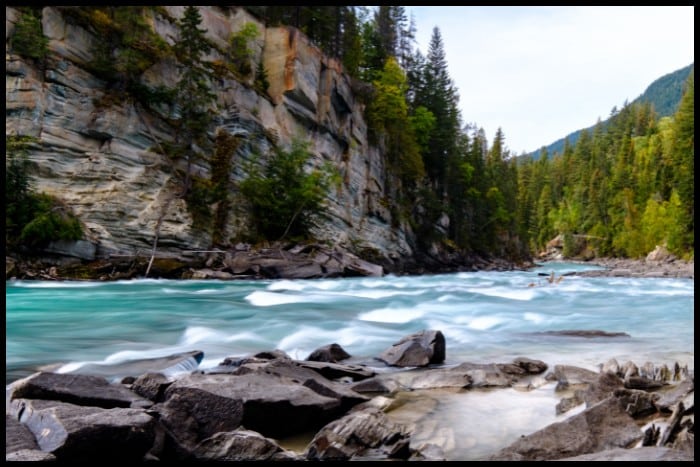
5. Outside Edges of Rapids Provide Cover
Trout are often found at the outside edges of rapids in rivers, which can provide a variety of benefits for the fish.
The water flowing over the rapids can help to oxygenate the water, making it more suitable for trout to breathe.
The faster-moving water also dislodges insects and other prey items, providing a rich food source for the fish. Trout can often be found waiting at the outside edges of rapids to ambush passing prey.
6. Any Still or Deep Water
Trout are often found in still and deep water in rivers, which can provide various benefits for the fish.
These areas can provide a more stable environment for the fish, with less current and more consistent water temperatures.
Deep water can be particularly important during periods of high heat or low water flow when other areas of the river may become unsuitable for trout.
Additionally, still and deep water can provide cover and protection for the fish from predators and a place to rest and conserve energy.
As such, these areas can be productive locations for anglers looking to target trout in rivers, particularly during periods of low activity when the fish may be less likely to feed actively.
Conclusion
In conclusion, trout fishing in rivers requires careful planning and preparation to increase the chances of success. Choosing the right equipment, location, and bait is essential for a productive day on the water.
It’s essential to be patient and observant, understanding the behavior of the fish and the water currents.
Learning to cast accurately and quietly, and adapting to changing conditions, can also make a significant difference.
With practice and persistence, trout fishing in rivers can be a rewarding and enjoyable experience for anglers of all skill levels.
